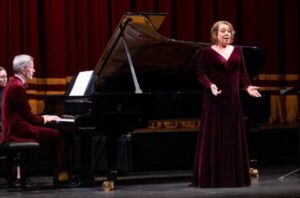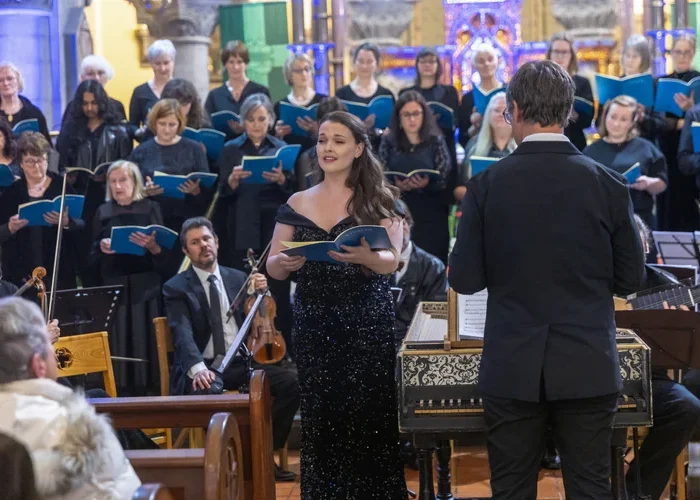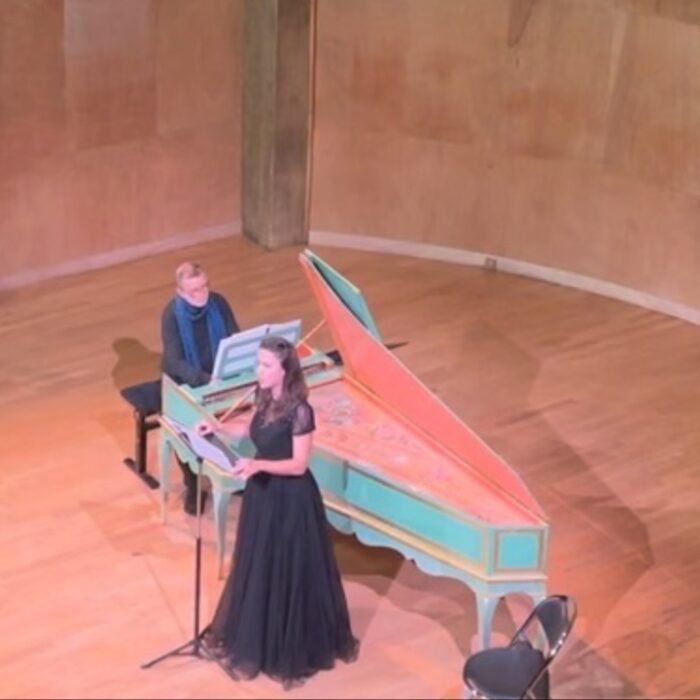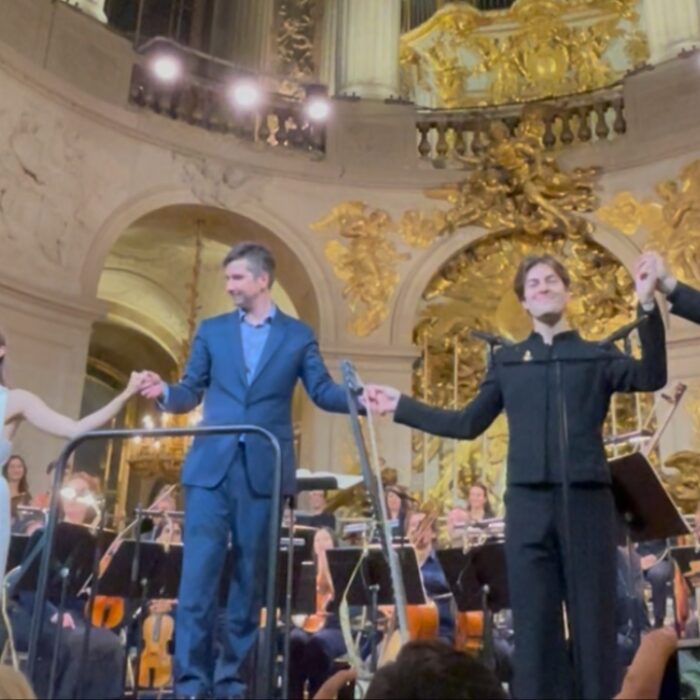
Zellerbach Hall 2023 Review: Nina Stemme in Recital
By Lois SilversteinOn a cloudy California afternoon, Berkeley’s Zellerbach Hall was bright with musical radiance. Nina Stemme, the great Swedish dramatic soprano, entered adorned in a red velvet gown. Her very presence cast light. From Wagner to Mahler, and Sigurd von Koch to Kurt Weill, the recital was full of beauty. This was opera royalty, “right here in river city.” Her pianist, Magnus Svensson, wore a matching wine red velvet suit and joined her on the musical journey.
Nina Stemme is known for her dramatic interpretations, both vocally and theatrically, as Isolde, Elektra, Brunhilde. Her recital focused on the introspective until the last part where she introduced the live wire music of cabaret.
Wesendonck Lieder
Wagner’s “Wesendonck Lieder” opened the program. The poems, written by Mathilde Wesendonck for her beloved Richard Wagner, were performed with technical perfection, timing, pitch, and rhythm. However, it was a different take on the quietude and pleading that spelled out the Wesendonck text; the inward contemplation, the solitary focus, and the longing.
Stemme’s strong and steely tone declaimed emotion rather than tracing its streaming flow. It was hard to avoid the performative aspect, with a voice that stentorian, with its declaration and decided determination. While the tone and intensity were beauteous, the piece stepped into a different direction from the delicacy of spirit often associated with the work, notably in “Der Engel,” where the faraway, then descending angel remained distant throughout.
This was at first a challenge. With “Im Treibhaus,” the poignancy became less remote and distant so that the poignant line, “Uns’re Heimat ist nicht hier (Our home is not here),” remained constant across the artistic board. Wagner’s use of piano accompaniment repeating the melodic line when the words were done remained as a striking reminder of the arc of pain.
With the opening, “Sonne,” of the next song, “Schmerzen,” Stemme struck gold with splendor. The audience could almost feel the heat. So too, the piano, after she completed the words, Svensson repeated the melodic line, this love song to pain, without a drop of sentimentality even more deeply resonating. A simple enough strategy but with significant effect.
A Piano Interlude
Before she proceeded to the work of Swedish composer, Sigurd von Koch’s lesser known cycle, “Die geheimnisvolle Flôte,” an interesting cycle based on Hans Bethge’s poems which Stemme sang with the same haunting restraint, Magnus Svensson played Liszt’s arrangement of Wagner’s “Am Stillen Herd” from “Die Meistersinger.” It was Liszt’s transcription, something he did with Wagner and other’s music.
Full of flourishes on the piano, trills, elaborate arpeggios, and multitudinous decoration, the plaintive ballad-style piece received an entirely distinctive treatment by Liszt as performed by Svensson. Here there was virtuosity and melody with the cross-handed repetitions and strong forte decoration coupled with pianissimi trills, that altered the touching work and located it in the realm of Liszt’s performative hot-house. Svensson adorned the piece in this spirit, by sometimes raising and sometimes blurring the extravagant romanticism; a fascinating excursion.
A Dark Second Half
The second half of the concert was all Mahler and Weill. The dark “Kindertotenlieder” received a similar treatment to the Wesendonck lieder—strong, resonate, and impressive. For those of us imprinted with Kathleen Ferrier’s version with Bruno Walter from 1948, it was a different journey through the cycle’s poignancy. Instead of enfolding intimacy, it was a rendition that bespoke dignity and distance, power and restraint; feelings that enhanced the dimensions of Friedrich Rückert’s cycle. Reckoning with loss built on restraint and distance despite the enormity of grief, offered a rich perspective with its more detached style of expression. It was rich music from the ardor and thoughtfulness of a fine singer.
The dark themes presented a new statement. Here was pride and distance in dealing with loss, restraint and dignity in the face of enormous grief, instead of vulnerability. Here was a woman who stayed steady in the face of unbearable sadness, regal in fact. Restraint and a refusal to knuckle under pain and grief in the spirit of Isolde and Brunhilde inspired a new perspective. So too, the touching “Oft denk’ich , sie sind nur ausgegangen (Often I think they have only gone out)” and “Bald warden sie wieder each Hause gelangen (Soon, they’ll be home again),” about the dead children. Whatever way they say it, the cut remains, and the scar still reminds.
“In diesem Wetter, in diesem Braus,” with its stunning repetitive variation at the beginning of each stanza, Stemme’s voice quieted and intensified as she descended to the final, “sie ruh’n sie ruh’n wie in der Mutter Haus (they rest, they rest, as if in their Mother’s house).” Here she was, giving us both perspective and pain in one moving tonality. An experience that looked in both directions at once. This was what we go to such music. What a gift.
Finishing with Weill
With the Weill, a new dimension of Stemme appeared. She embodied here and now, sexy, teasing, taunting, as well as telling. She took a stance out from the piano and engaged the audience with Weill’s rhythmic shifts, tensions, off-rhymes, short lines, and Berthold Brecht’s lyrics. She accented these with aplomb.
She animated her sound with a desire to reach the audience and imprint the piquancy, through the multi-layered richness of her sound. It was almost surprising, in fact, the regal bearing of the first songs she replaced with the standing as if in the middle of nowhere, i.e., away from the piano, with arms extending and extended. She gave us both character and characterization. “Surabaya Johnny” was vital and a fine contrast to what preceded.
So too was “Nanna’s Lied” by Brecht, where Stemme’s low tones emerged with flexibility, a distinctive possibility of vigor, a musical “sprechstimme” that stood out after the lyricism of the earlier Wagner.
In “Youkali” by Roger Fernay, we enjoyed a tango rhythm where she allowed her hands, body, head, and face to range and express more than she did earlier. It was as if she had excavated feelings that were hardly expected. Stemme seemed quite at home while singing French and the song attained over three dimensions. It delighted.
Here was the union we saw in her well-known Strauss and Wagner performances, the intensity, the drive, the curled lioness unleashing her powers, but not without direction or focus. Her intelligence shone. Her choices reached under the skin.
Stemme and Svensson gave us one encore, “My Ship,” a Broadway tune from “Lady in the Dark,” and in English, leaving us with a bravado sound and spirit that left no doubts about their extraordinary gifts.


